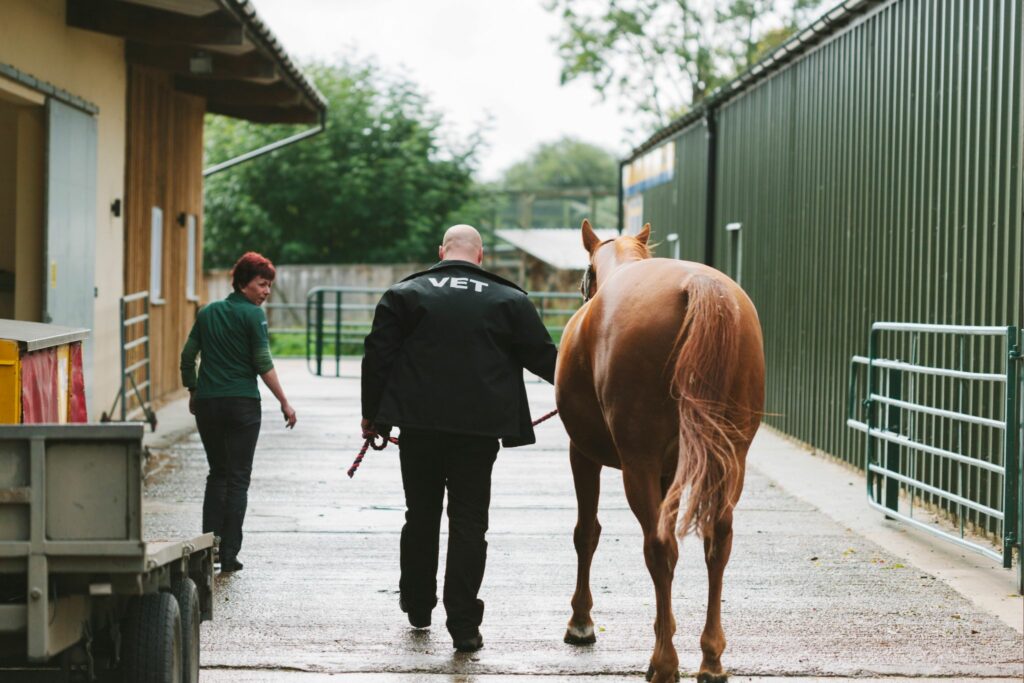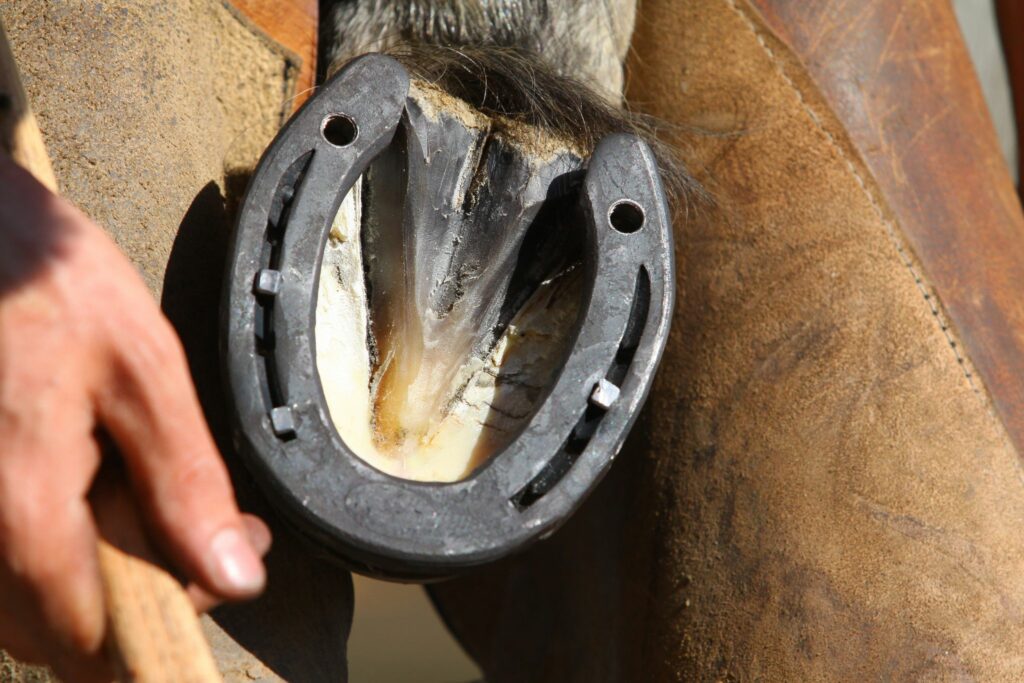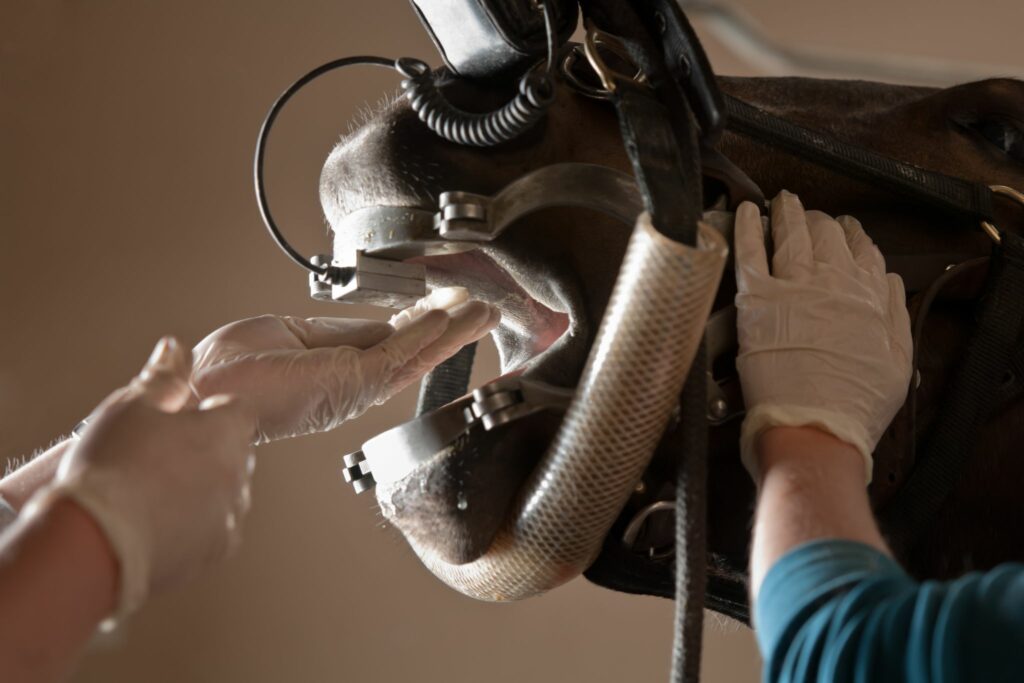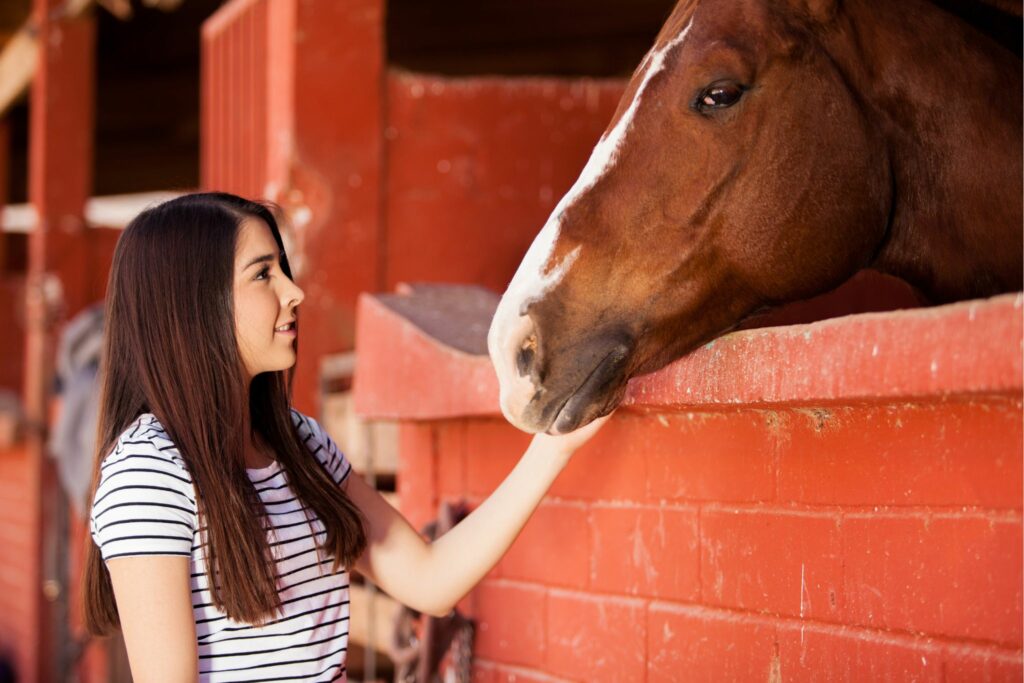Horse News
Member
A Handy List of Horse Health Terms
Recognizing and understanding health problems is an important part of owning a horse. Many times, early recognition of health issues can be lifesaving! Here is a handy list of terms and what they mean.
This horse health glossary is broken into five sections: hoof health, general health, equine disease, dental health, and equine medications. Each of these five aspects of your horse’s health is essential to his overall well-being.
Pro tip: If you’re looking for a specific term, hit Control + F on Windows (Command + F on Mac), then type in the word you’re looking for!
Horse Health: The Basics
This isn’t an all-encompassing list, but rather a targeted compilation of the most common conditions and issues. We’ve categorized terms into three main parts (hooves, teeth, and body), as well as diseases and commonly prescribed medicines.

Source: Canva
Hoof Health
Without a hoof, you don’t have a horse. Hooves may be only a small part of your horse, but hoof health is paramount to keeping the rest of your horse up and running (pun intended).

Source: Canva
Abscess
An abscess is a pocket of infected puss in either the hoof or the sole. The pocket must be drained to heal. Treatment usually involves soaking the hoof in Epsom salt, then bandaging.
Bruise
A bruise is a common cause of lameness that happens when the blood vessels underneath your horse’s sole have been damaged. Stepping wrong on a rock or hard surface usually causes one. Rest, ice, and an anti-inflammatory are used to treat bruises.
Cracks
A crack is a split in the hoof wall, usually caused by poor farrier work, poor hoof health, or white line disease. Cracks can be minor or create lameness issues. A qualified farrier is instrumental in fixing hoof cracks.
Puncture Wounds
A puncture wound to the hoof is when a sharp object embeds in or penetrates the sole or frog. The object must be removed, and the area is usually poulticed and wrapped. Infections can happen, so call your vet if your horse becomes lame in the next day or two.
Thrush
Thrush is an infection of the frog that oozes a smelly black puss. Treatment involves cleaning out the infection and treating the area with antibacterial and antifungal medications.
White Line Disease
White line disease is a bacterial and fungal infection that attacks the tissue of the hoof wall, recognized by a series of fissures and cracks (no actual white lines are involved).
A skilled farrier can address this issue, which may require the temporary use of shoes or the application of hoof oil to restrengthen the hoof wall.
General Health
Here are some general issues your horse may experience.
Cribbing
Cribbing is when a horse sucks in air while resting his teeth on a ledge (like a fence). While the action itself is rarely dangerous, it can lead to more serious issues like weight loss, poor dental health, and colic. Cribbing can be controlled with a collar.
Lameness
Lameness is any abnormal movement caused by inflammation, infection, or injury in a horse’s leg. Any leg can be affected for any number of reasons. You’ll probably need to call your vet and use rest and anti-inflammatories to help your horse recover.
Quidding
Quidding is when a horse partially chews and then spits out his food. Quidding is usually caused by poor dental health. Your vet or a qualified equine dentist should be called to float (trim) your horse’s teeth.
Stocking Up
Stocking up is a fancy way of saying there is swelling in your horse’s legs, typically from fluid that has accumulated beneath the skin. Lack of movement is usually the culprit. Increasing movement or turnout usually eliminates this problem.
Vaccinations
Vaccinations help protect your horse from various diseases, some of which are life-threatening. Your horse will typically need vaccines twice a year, in the spring and fall.
Vital Signs
Vital signs paint a quick picture of your horse’s overall health. They include:
- Temperature: normal is 99 to 101.5 degrees Fahrenheit
- Pulse: normal is between 28 and 44 beats per minute
- Respiration: normal is 10 to 24 breaths per minute
- Mucous membranes: normal gums should be pinky, wet, and shiny
- Capillary refill: press your thumb on your horse’s gum for three seconds, then release. Color should return in 1 to 2 seconds
- Skin pliability: a test for dehydration. Pinch a fold of your horse’s skin on the shoulder or neck into a “tent,” then release. The skin should fall flat within 1.5 seconds
Equine Disease
A disease is a disorder of function or structure that has distinct symptoms or causes recognizable physical changes.

Source: Canva
Bowed Tendon
A bowed tendon is swelling of the tendon in the lower part of the leg that causes the tendon to bow outwards. Bowed tendons are severe, and healing requires complete rest and anti-inflammatories. Full recovery can take eight months to a year.
Choke
Choke is when the esophagus, or throat, is obstructed by food (or sometimes by a tumor). This is common in horses who “inhale” their food. Soaking feed can help prevent this.
Colic
Colic refers to abdominal, or stomach and intestinal, pain caused by gas, torsion (twisting), or impaction (constipation). Colic can be minor or severe and is sometimes fatal. ALWAYS CALL YOUR VET.
Treatment varies depending on severity but ranges from walking and pain meds to administration of fluids or surgery.
Cushing’s Syndrome (PPID)
Cushing’s Syndrome is the most common endocrine (glands and hormones) disorder in horses. The adrenal gland is overactive, causing symptoms like a long, curly coat, lack of shedding, or laminitis.
Cushing’s Syndrome can be managed with daily medication and diet; consult your vet.
Equine Infectious Anemia (EIA)
Sometimes called swamp fever, EIA is a chronic infection caused by a retrovirus. There is no vaccine or treatment for this disease. Signs include recurring fevers, anemia, rapid weight loss, and swelling. This disease is fatal about 50% of the time.
Founder
Also referred to as laminitis, founder is when the laminae of the hoof become inflamed. Signs include heat in the hoof or resistance to movement.
Founder refers to the most advanced stage of laminitis when the coffin bone rotates or tears away from the hoof wall.
Heaves (COPD)
Heaves is a chronic allergic respiratory disease (think of it like an asthma attack triggered by straw or hay that causes the airways to become inflamed).
Keeping your horse outside, watering his hay, and using corticosteroids or bronchodilators (things that open the airway) can help.
Hives
Hives are an allergic skin reaction that has various triggers, including medications, chemicals, and insect bites. Cold hosing can help, and sometimes medication is needed. Hives are usually not life-threatening, just really itchy.
Insulin Resistance (Equine Metabolic Syndrome)
Insulin resistance is when the body becomes less reactive to insulin, which regulates glucose (sugar) in the bloodstream. Treatment involves exercise and a low-sugar, low-starch diet.
Laminitis
Laminitis, also called founder, is when the laminae of the hoof become inflamed. Horses with laminitis should have limited grass turnout and eat low-sugar, low-starch grain. A horse can recover from laminitis but is likely to experience it again.
Navicular Syndrome
Navicular syndrome is the progressive degeneration of the navicular bone in the hoof. Rest and anti-inflammatories can help manage this condition. This disease will get worse with time and eventually cause a horse to retire.
Osteochondritis Dissecans (OCD)
OCD is when there are large flaps of cartilage, or the connective tissue that protects bones and joints, within a joint. Surgery is usually required to correct this issue.
Rain Rot
Rain rot is a skin infection caused by bacteria on the skin. While this bacteria is normally dormant (and therefore harmless), wet conditions can create an inflammatory response.
If treated early, recovery is usually quick. Antibacterial shampoos and apple cider vinegar can help treat rain rot.
Scratches
Sometimes called greasy heel, scratches is an inflammation of the skin of the lower legs from bacteria. Scratches is usually caused by prolonged exposure to moisture.
Treatment requires a dry environment and a round of antibiotics, steroids, or antifungal medication.
Strangles
Strangles is a highly contagious bacterial infection that causes swelling and inflammation. Most cases are treated with rest, though some may need antibiotics.
Sweet Itch
Sweet itch is an allergic reaction to midge or mosquito bites. Treatment involves antihistamines. Sweet itch can be prevented with the regular application of insect repellent or the use of a fly sheet.
Uveitis
Uveitis is irritation or inflammation of the uvea, a layer of the eye. Treatment usually involves eye drops. This condition can be one-time or chronic. (Appaloosas are far more likely to develop chronic uveitis, which typically leads to blindness.)
West Nile Virus
West Nile Virus is a viral disease that causes fevers and neurological problems. There is a vaccine to protect against it.
Dental Health
Teeth are often overlooked in horses but can be the cause of many health and behavioral issues.

Source: Canva
Cap
A cap is a baby tooth that rests on the adult (or permanent) tooth before it erupts.
Crown
The crown is the part of the tooth above the gum used for grinding.
Deciduous Teeth
Deciduous teeth is a fancy term for baby teeth.
Incisors
Incisors are the front teeth, used to pull grass and nip (and sometimes to bite).
Mastication
Mastication is a fancy term for chewing or grinding food.
Maxillary Teeth
Maxillary teeth are the teeth on the upper jaw (not the incisors, but the molars).
Molars
Molars are the second three sets of cheek teeth on the top and bottom jaw that grind food. Horses don’t have baby molars. Rather, molars erupt when a horse is about three years old.
Occlusion/Malocclusion
An occlusion is where opposing teeth (top and bottom) contact each other (what makes chewing possible). A malocclusion is when the contact between these opposing teeth is abnormal, usually due to uneven wear.
Vets and equine dentists can resolve malocclusions through floating.
Wolf Teeth
Wolf teeth are small, pointed teeth that sit directly in front of the first upper cheek teeth (or molars). Not all horses have them. Those that do usually need to have them pulled, as they can cause pain or discomfort with a bit.
Equine Medications
Medications are an important part of managing many conditions in horses.

Source: Canva
Acepromazine
Usually called ace, acepromazine is a common tranquilizer or sedative. It can be used to calm a horse during a vet exam, treatment or transport.
Banamine
Banamine is a nonsteroidal anti-inflammatory (or NSAID) that relieves fever, swelling, and pain. It can be given orally or through an injection. It’s frequently used to treat colic.
Dexamethasone
Usually called dex, dexamethasone is used to treat respiratory allergies, hives, arthritis, and COPD (heaves).
Dormosedan Gel
Also known as dorm, Dormosedan Gel is a sedative. It’s a gel that’s applied under the tongue about forty minutes before an exam or procedure. Dorm is a common choice to use when the dentist comes. It does not require a veterinarian for administration.
Ivermectin
Ivermectin is used to prevent heartworm disease and treat parasites. Ivermectin (and other drugs) are usually referred to as dewormers. Most horses will need ivermectin once per year.
Phenylbutazone
Phenylbutazone, better known as bute, is an NSAID used to relieve pain and reduce inflammation. It’s used to treat or manage a wide range of conditions.
Bute is most commonly fed as a powder (if you mix bute with sugar-free maple syrup and use an oral syringe, your horse is less likely to spit it out).
Trimethoprim Sulfa
Trimethoprim Sulfa is a common, broad-spectrum antibiotic used to treat several different types of infections.
Xylazine
Xylazine is a common sedative. It can also be used to help manage and treat colic.

Source: Canva
Parting Thoughts
Horses, like any animal, come with a lot of potential health problems. It’s much easier to keep a horse healthy if you know what to look for. Treating these conditions at the first signs makes recovery much easier, just as knowing about these conditions can help you take the proper steps to prevent them.
We think it’s a great idea to print out this list and keep it at the barn as a handy reference guide!
P.S. Enjoy this article? Trot on over to:
- Horse Hoof Terminology
- Horse care 101: Turnout blankets vs. stable blankets
- Horse Riding Equipment List: What You Need & What You Don’t
- Get a Leg Up on Equine Limb Terminology
- Beginner’s Guide to Horse Hay Nets & Bags
- Horse Riding Gear for Beginners (Quick Print Equipment List)
- The Ultimate Packing & Horse Trailering Checklist
- What Gear Do You Need to Ride Horses as an Adult
- 99 Fun & Incredible Horse Facts for Kids
Sources
Horse Illustrated: Horse Health Glossary
AAEP: Equine Dental Glossary
The Horse: Glossary
The post A Handy List of 47 “Must Know” Horse Health Terms appeared first on Horse Rookie.
Continue reading...
